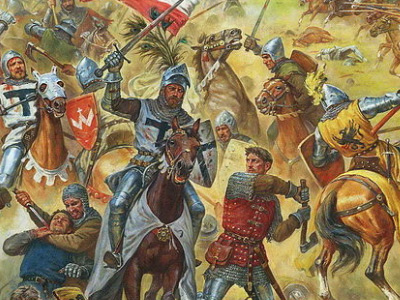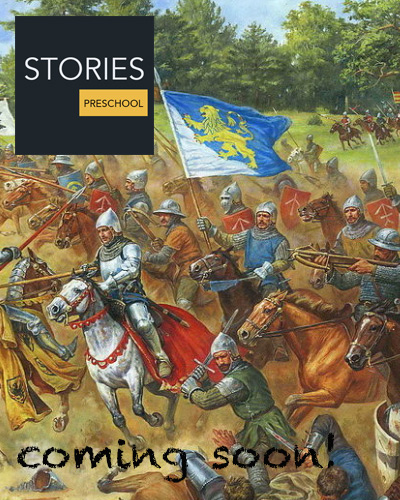Battle of Grunwald (1410)
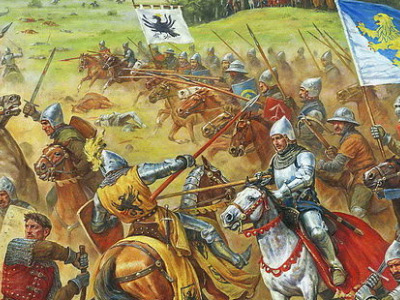
Course of the Battle
March into Prussia
The first stage of the Grunwald campaign was the gathering of all Polish–Lithuanian troops at Czerwinsk, a designated meeting point about 80 km (50 mi) from the Prussian border, where the joint army crossed the Vistula over a pontoon bridge. This maneuver, which required precision and intense coordination among multi-ethnic forces, was accomplished in about a week, from 24–30 June 1410. Polish soldiers from Greater Poland gathered in Poznań, and those from Lesser Poland, in Wolbórz. On 24 June 1410 Władysław II Jagiełło and Czech mercenaries arrived in Wolbórz. Three days later the Polish army was already at the meeting place. The Lithuanian army marched out from Vilnius on 3 June and joined the Ruthenian (modern Belarus and Ukraine Ukraine is a country in Eastern Europe. It is the second-largest European country after Russia, which it borders to the east and northeast. Kyiv, also spelled Kiev, is the capital and most populous city of Ukraine. It is in north-central Ukraine along the Dnieper River. On 24 February 2022, Russia invaded Ukraine in a major escalation of the Russo-Ukrainian War that began in 2014.) regiments in Hrodna. They arrived in Czerwinsk on the same day the Poles crossed the river. After the crossing, Masovian troops under Siemowit IV and Janusz I joined the Polish–Lithuanian army. The massive force began its march north towards Marienburg (Malbork), capital of Prussia, on 3 July. The Prussian border was crossed on 9 July.
Ukraine is a country in Eastern Europe. It is the second-largest European country after Russia, which it borders to the east and northeast. Kyiv, also spelled Kiev, is the capital and most populous city of Ukraine. It is in north-central Ukraine along the Dnieper River. On 24 February 2022, Russia invaded Ukraine in a major escalation of the Russo-Ukrainian War that began in 2014.) regiments in Hrodna. They arrived in Czerwinsk on the same day the Poles crossed the river. After the crossing, Masovian troops under Siemowit IV and Janusz I joined the Polish–Lithuanian army. The massive force began its march north towards Marienburg (Malbork), capital of Prussia, on 3 July. The Prussian border was crossed on 9 July.
The river crossing remained secret until Hungarian envoys, who were attempting to negotiate a peace, informed the Grand Master. As soon as Ulrich von Jungingen grasped the Polish–Lithuanian intentions, he left 3,000 men at Schwetz (Świecie) under Heinrich von Plauen and marched the main force to organize a line of defense on the Drewenz River (Drwęca) near Kauernik (Kurzętnik). The river crossing was fortified with stockades. On 11 July, after meeting with his eight-member war council, Władysław II Jagiełło decided against crossing the river at such a strong, defensible position. The army would instead bypass the river crossing by turning east, towards its sources, where no other major rivers separated his army from Marienburg. The march continued east towards Soldau (Działdowo), although no attempt was made to capture the town. The Teutonic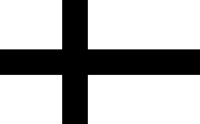 The Teutonic Order is a Catholic religious institution founded as a military society c. 1190 in Acre, Kingdom of Jerusalem. The Order of Brothers of the German House of Saint Mary in Jerusalem was formed to aid Christians on their pilgrimages to the Holy Land and to establish hospitals. Its members have commonly been known as the Teutonic Knights, having a small voluntary and mercenary military membership, serving as a crusading military order for the protection of Christians in the Holy Land and the Baltics during the Middle Ages. army followed the Drewenz River north, crossed it near Löbau (Lubawa) and then moved east in parallel with the Polish–Lithuanian army. According to the Order propaganda the latter ravaged the village of Gilgenburg (Dąbrówno). Later, in the self-serving testimonies of the survivors before the Pope the Order claimed that Von Jungingen was so enraged by the alleged atrocities that he swore to defeat the invaders in battle.
The Teutonic Order is a Catholic religious institution founded as a military society c. 1190 in Acre, Kingdom of Jerusalem. The Order of Brothers of the German House of Saint Mary in Jerusalem was formed to aid Christians on their pilgrimages to the Holy Land and to establish hospitals. Its members have commonly been known as the Teutonic Knights, having a small voluntary and mercenary military membership, serving as a crusading military order for the protection of Christians in the Holy Land and the Baltics during the Middle Ages. army followed the Drewenz River north, crossed it near Löbau (Lubawa) and then moved east in parallel with the Polish–Lithuanian army. According to the Order propaganda the latter ravaged the village of Gilgenburg (Dąbrówno). Later, in the self-serving testimonies of the survivors before the Pope the Order claimed that Von Jungingen was so enraged by the alleged atrocities that he swore to defeat the invaders in battle.
Battle Preparations
In the early morning of 15 July 1410 both armies met in an area covering approximately 4 km2 (1.5 sq mi) between the villages of Grunwald, Tannenberg (Stębark) and Ludwigsdorf (Łodwigowo). The armies formed opposing lines along a northeast–southwest axis. The Polish–Lithuanian army was positioned in front and east of Ludwigsdorf and Tannenberg. Polish heavy cavalry formed the left flank, Lithuanian light cavalry the right flank and various mercenary troops made up the center. Their men were organized in three lines of wedge-shaped formations about 20 men deep. The Teutonic forces concentrated their elite heavy cavalry, commanded by Grand Marshal Frederic von Wallenrode, against the Lithuanians. The Knights, who were the first to organize their army for the battle, hoped to provoke the Poles or Lithuanians into attacking first. Their troops, wearing heavy armor, had to stand in the scorching sun for several hours waiting for an attack. One chronicle suggested that they had dug pits that an attacking army would fall into. They also attempted to use field artillery, but a light rain dampened their powder and only two cannon shots were fired. As Władysław II Jagiełło delayed, the Grand Master sent messengers with two swords to "assist Władysław II Jagiełło and Vytautas in battle". The swords were meant as an insult and a provocation. Known as the "Grunwald Swords", they became one of the national symbols of Poland.
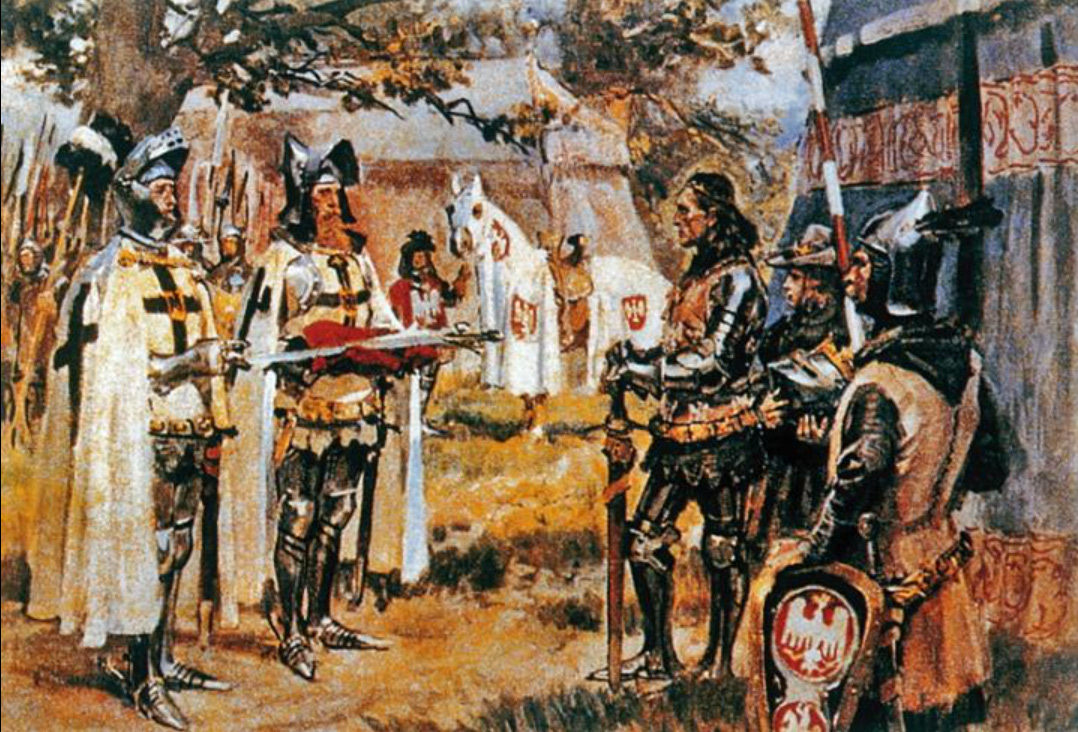
Teutonic Order presents Grunwald Swords as gift to King Władysław II Jagiełło (painting by Wojciech Kossak)
Battle Begins: Lithuanian attack and tactical retreat
Vytautas, supported by a few Polish banners, started an assault on the left flank of the Teutonic forces. After more than an hour of heavy fighting the Lithuanian light cavalry began a full retreat. Jan Długosz described this development as a complete annihilation of the entire Lithuanian army. According to Długosz, the Knights assumed that victory was theirs, broke their formation for a disorganized pursuit of the retreating Lithuanians and gathered much loot before returning to the battlefield to face the Polish troops. He made no mention of the Lithuanians, who later returned to the battlefield. Thus Długosz portrayed the battle as a single-handed Polish victory. This view contradicted Cronica conflictus and has been challenged by modern historians. Starting with an article by Vaclaw Lastowski in 1909, they proposed that the retreat was a planned, strategic maneuver borrowed from the Golden Horde. A false retreat was used in the Battle of the Vorskla River of 1399, where the Lithuanian army was dealt a crushing defeat and Vytautas himself barely escaped alive. This theory gained wider acceptance after the discovery and publication of a German letter by Swedish historian Sven Ekdahl in 1963. The letter, written a few years after the battle, cautions the new Grand Master to look out for false retreats of the kind that were used in the Great Battle. Stephen Turnbull asserted that the Lithuanian tactical retreat did not quite fit the tried formula of a false retreat. Such a retreat was usually staged by one or two units (as opposed to almost an entire army) and was swiftly followed by a counterattack (whereas the Lithuanians returned late in the battle).
Battle Continues: Polish–Teutonic fight
While the Lithuanians were retreating, heavy fighting broke out between Polish and Teutonic forces. Commanded by Grand Komtur Kuno von Lichtenstein, the Teutonic forces concentrated on the Polish right flank. Six of von Walenrode's banners did not pursue the retreating Lithuanians, instead joining the attack on the right flank. A particularly valuable target was the royal banner of Kraków. It seemed that the Knights were gaining the upper hand, and at one point the royal standard-bearer, Marcin of Wrocimowice, lost the Kraków banner. However, it was soon recaptured and fighting continued. Władysław II Jagiełło deployed his reserves—the second line of his army. Grand Master Ulrich von Jungingen then personally led 16 banners, almost a third of the original Teutonic strength, to the right Polish flank, and Władysław II Jagiełło deployed his last reserves, the third line of his army. The melee reached the Polish command and one Knight, identified as Lupold or Diepold of Kökeritz, charged directly against King Władysław II Jagiełło. Władysław's secretary, Zbigniew Oleśnicki, saved the king's life, gaining royal favor and becoming one of the most influential people in Poland.
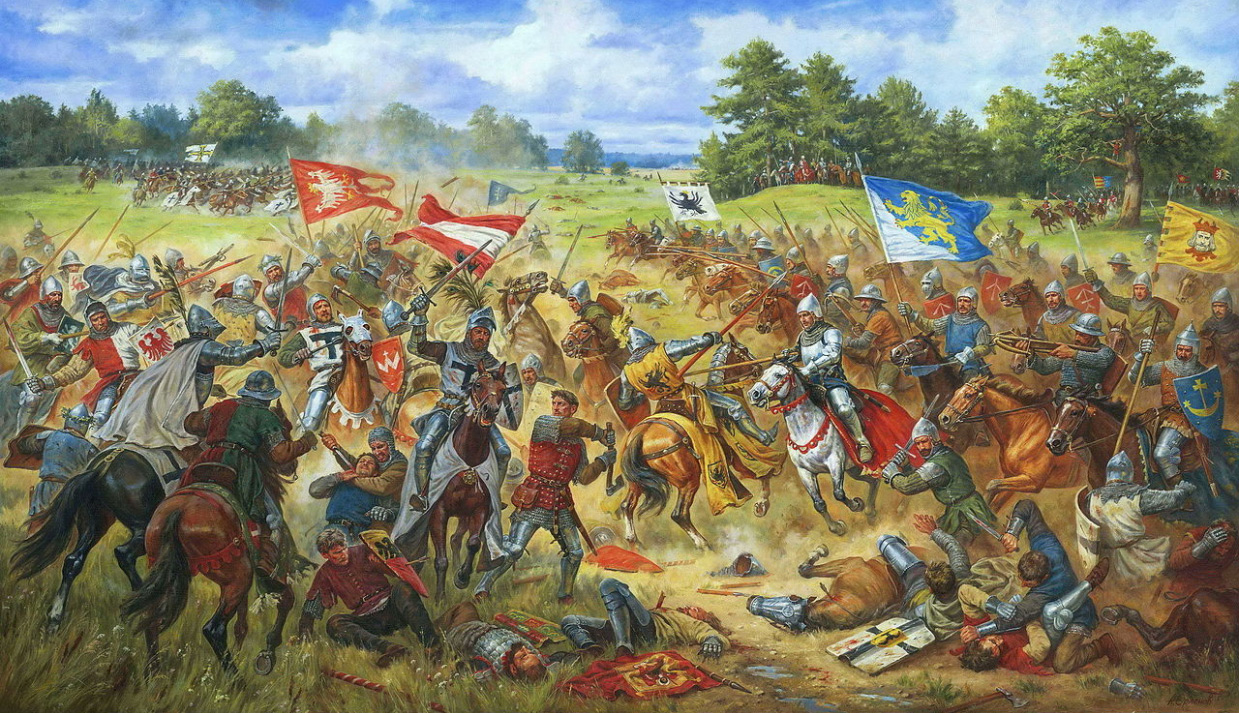
Banners of the Kingdom of Poland and Lwów Land during the battle.

Banners of the Kingdom of Poland and Lwów Land during the battle.
( Click image to enlarge)
Battle Ends: Teutonic Knights defeated
At that time the reorganized Lithuanians returned to the battle, attacking von Jungingen from the rear. The Teutonic forces were by then becoming outnumbered by the mass of Polish knights and advancing Lithuanian cavalry. As von Jungingen attempted to break through the Lithuanian lines, he was killed. According to Cronica conflictus, Dobiesław of Oleśnica thrust a lance through the Grand Master's neck, while Długosz presented Mszczuj of Skrzynno as the killer. Surrounded and leaderless, the Teutonic Knights began to retreat. Part of the routed units retreated towards their camp. This move backfired when the camp followers turned against their masters and joined the manhunt. The knights attempted to build a wagon fort: The camp was surrounded by wagons serving as an improvised fortification. However, the defense was soon broken and the camp was ravaged. According to Cronica conflictus, more Knights died there than on the battlefield. The battle lasted for about ten hours.
The Teutonic Knights attributed the defeat to treason on the part of Nikolaus von Renys (Mikołaj of Ryńsk), commander of the Culm (Chełmno) banner, and he was beheaded without a trial. He was the founder and leader of the Lizard Union, a group of Knights sympathetic to Poland. According to the Knights, von Renys lowered his banner, which was taken as a signal of surrender and led to the panicked retreat. The legend that the Knights were "stabbed in the back" was echoed in the post-World War I World War I, also known as the First World War, or the Great War, was a global war originating in Europe that lasted from 28 July 1914 to 11 November 1918. More than 70 million military personnel, including 60 million Europeans, were mobilized in one of the largest wars in history. The war drew in all the world's economic great powers, assembled in two opposing alliances: the Allies versus the Central Powers of Germany and Austria-Hungary. View World War I » stab-in-the-back legend and preoccupied German historiography of the battle until 1945.
World War I, also known as the First World War, or the Great War, was a global war originating in Europe that lasted from 28 July 1914 to 11 November 1918. More than 70 million military personnel, including 60 million Europeans, were mobilized in one of the largest wars in history. The war drew in all the world's economic great powers, assembled in two opposing alliances: the Allies versus the Central Powers of Germany and Austria-Hungary. View World War I » stab-in-the-back legend and preoccupied German historiography of the battle until 1945.
HISTORY
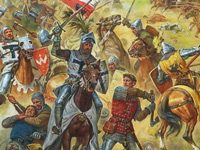
RESOURCES
This article uses material from the Wikipedia article "Battle of Grunwald (1410)", which is released under the Creative Commons Attribution-Share-Alike License 3.0.
© Stories Preschool. All Rights Reserved.
